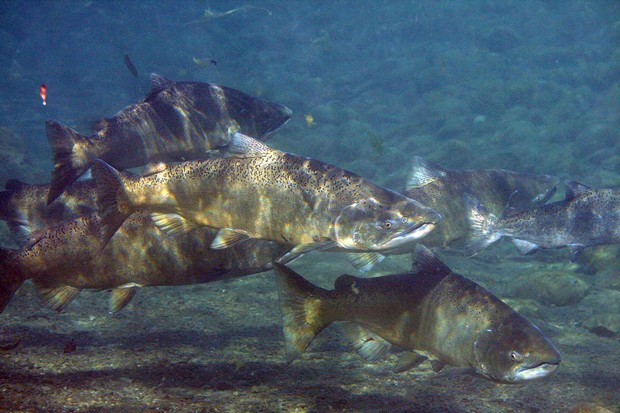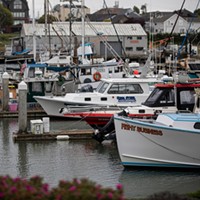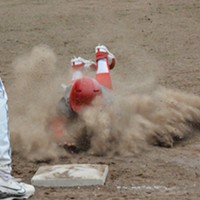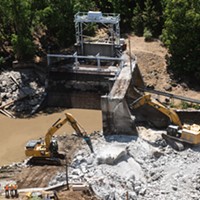Salmon in the Middle
As conservation efforts begin bearing fruit, drought conditions threaten local fisheries
By David Simpson[
{
"name": "Top Stories Video Pair",
"insertPoint": "7",
"component": "17087298",
"parentWrapperClass": "fdn-ads-inline-content-block",
"requiredCountToDisplay": "1"
}
]
The schools of large adult Chinook salmon swimming back and forth in most pools of the lower Mattole River from November to mid-January offered a powerful testament to both the resilience of these remarkable fish and to the challenges they now face in light of climate change and California's pernicious drought.
Many people still remember the dry years of the mid-1970s — especially 1976-77, the driest water year (July 1 through June 30) on record up to now. One bright warm day followed another that winter and the night skies were filled with stars. Loggers complained of having no work-stopping rainy days to give them a little winter's rest. Many smaller creeks and springs simply stopped running as the warm season progressed. Salmon returning in the fall were, like this year, stuck in the pools in lower rivers, increasingly vulnerable to poaching. The rainfall total that year, at 25 inches in the lower Mattole Valley, was then the lowest on record, lower than the dry year of 1929.
Decades later, Humboldt County is coming off its driest December and January ever recorded. Nancy Dean, meteorologist at the National Weather Service office in Eureka, said this year's two-month total of 1.91 inches has replaced 1976-77 as the lowest combined total for the two months since the National Weather Service began keeping track. And that bleak measurement comes on the heels of last calendar year's anemic rainfall total of 16.6 inches in Eureka — a total that set a new single-year record, coming in more than 23 inches below normal. Stream flow in the Mattole River at its driest in January of 1977 was 89 cubic feet per second (cfs). Comparatively, on the same day in 2014, the flow was just below 54 cfs, a level far more common in late August. Before the rain began falling on Feb. 5, only 6.3 inches of precipitation had been recorded in the lower Mattole since July 1, about 12 percent of seasonal average.
Statewide, the water content of the rapidly waning Sierra snowpack has fallen to 15 percent of normal, forcing officials to cut off water allocations from the State Water Project to local agencies that serve 25 million residents and 750,000 acres of farmland throughout the state.
Though the droughts of 1976-77 and 2013-14 are remarkably similar in terms of the timing and amounts of rainfall, changes have taken place since 1977 that affect local watersheds profoundly, making them both more vulnerable to droughts and more resistant to them. In 1977, fewer people inhabited the Humboldt countryside. At the same time, our once-bountiful salmon runs were in rapid decline, victims of over-fishing, habitat damage and two great floods.
A migration of people out of cities and back to the land has combined with the marijuana boom to steadily increase populations in Humboldt's remote watersheds. Deleterious effects on the land, though, and an increased demand for water have been partly balanced by strong commitments to watershed restoration and sustainability on the parts of many newcomers and established ranch families alike.
Thanks to improved freshwater habitat, fairly moist spring seasons and good offshore feeding conditions, the fish have started to respond. Even the great, dam-congested Columbia to the north had its strongest return this year — over 1 million spawners — since 1936.
Locally, the Eel River Project estimates that 30,000 to 50,000 chinook returned to spawn in the river last year. "We had an absolutely banner year in 2012-13," said Patrick Higgins, a biologist working with the project. This year's numbers are below last year's, "but were still good," he said.
Sara Bolock , an environmental scientist with the California Department of Fish and Wildlife, reports that over 320,000 chinook, the highest number since 1978, returned to spawn in the Klamath in 2012-13. Less than half that — about 140,000 — came back this year, according to Taz Soto, head of the Karuk Tribe fisheries program in the middle Klamath. "Fewer spawners showed up this year, but the run was still better than average," he said.
The Smith River, too, had its banner year recently — in 2011-12 — according to Fish and Wildlife's Justin Garwood.
These improved returns should be providing a sense of hope for the future of salmon. Unfortunately, the river systems they're returning to are wrung almost dry. Fry (very young salmon) hatched out low in the rivers miss the sheltered rearing habitats they normally encounter on their long migrations from headwaters. They'll be more vulnerable to hunger, predation and infestations common in over-warm lower rivers. There is also a danger that, if heavy rains break the drought, high flows could wash eggs or tiny fry out of the mobile gravels that are found in lower rivers.
Reginald Kennedy, hydrologist with the National Weather Service office in Eureka, points out that common culprits for extreme weather aren't around this year — no El Niño or La Niña. There is only this "tenacious high pressure ridge" locked firmly over the eastern Pacific from the tip of Baja to northern British Columbia, he said.
Normally, Kennedy said, the high pressure off the coast during the warm months gives way in fall to the powerful low-pressure systems formed in the Gulf of Alaska. Instead, this winter — not unlike in 1976-77 — the low-pressure disturbances are being forced north, "over the top" of the continent and into Canada, where they literally gather cold. The frigid lows then move with a looping jet stream down into the Midwest and the Eastern Seaboard, where they've been wreaking havoc. This year's deep freeze in the east is the other face of California's drought.
Gordon Leppig is the newly designated climate change coordinator and long-range planner for Fish and Wildlife on the north coast. Leppig, an avowed optimist, said in a recent interview that, "while it's impossible to point to any one weather event such as the drought and say, 'It's climate change,' this event fits all the predicted patterns: more intense, faster-moving droughts; less snowpack; lower springs and stream flows; extreme danger from wildfire."
Leppig's office is enjoined with the task of figuring how to reduce emissions in all areas of Fish and Wildlife resource management. At the same time, as a long-range planner in a drought-prone environment, he has to be concerned about land-use practices that impact water. He posed an old question for Californians, now newly urgent: "Is there enough water for agriculture, domestic use and for fish?"
In other words, we are facing new challenges to the coexistence of people and salmon just at a time when salmon seem to be showing signs of recovery. Can we adapt to these realities? Can salmon? Leppig painted an ominous picture. "Current research shows that if present population trends continue," he said, "we should anticipate 78 percent of California's 32 distinct native salmonid populations will likely be extinct within the next century."
While the rains that commenced earlier this month proved a welcome relief in our parched communities, Todd Flackus, a research analyst with the Department of Water Resources, said they do not impact California's drought status. "Even if we had above-average rainfall for the rest of February and March, we'd still be behind."
David Simpson is a freelance journalist and playwright, who co-founded the Mattole Salmon Group and currently sits on its board of directors. He lives near Petrolia in the Mattole Valley.
Speaking of...
more from the author
-
'Some Urgency'
Supes tap citizens group to join Climate Action Plan process
- Sep 19, 2019
-
COP 21: The First Week
- Dec 8, 2015
- More »
Latest in News
Readers also liked…
-
Through Mark Larson's Lens
A local photographer's favorite images of 2022 in Humboldt
- Jan 5, 2023
-
'To Celebrate Our Sovereignty'
Yurok Tribe to host gathering honoring 'ultimate river warrior' on the anniversary of the U.S. Supreme Court ruling that changed everything
- Jun 8, 2023





































